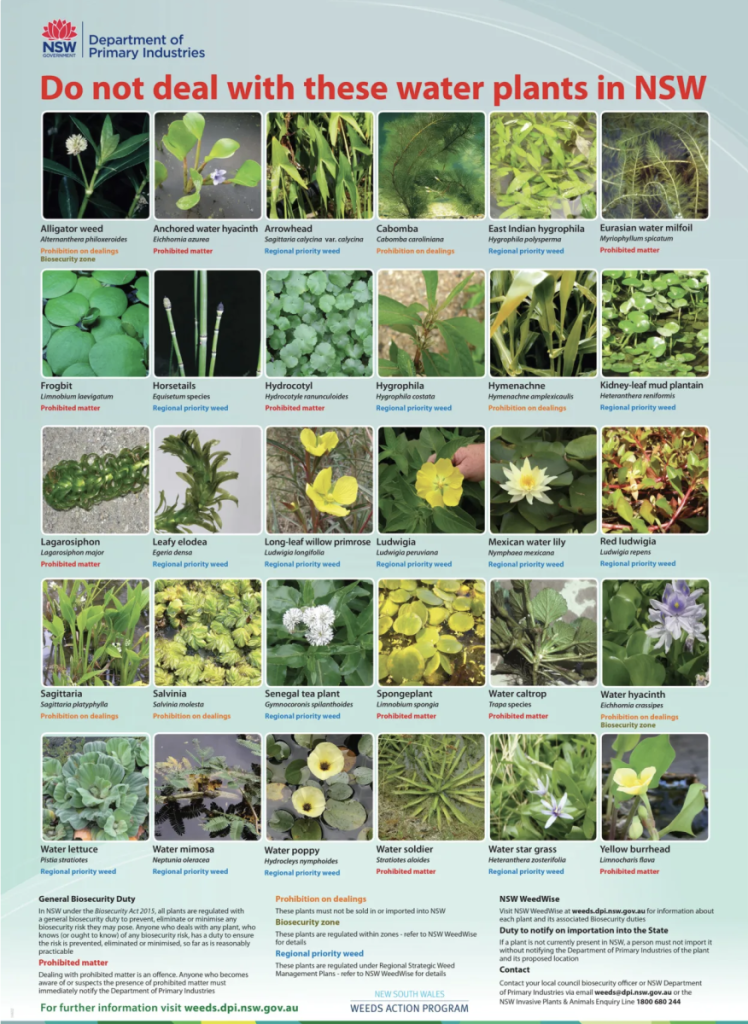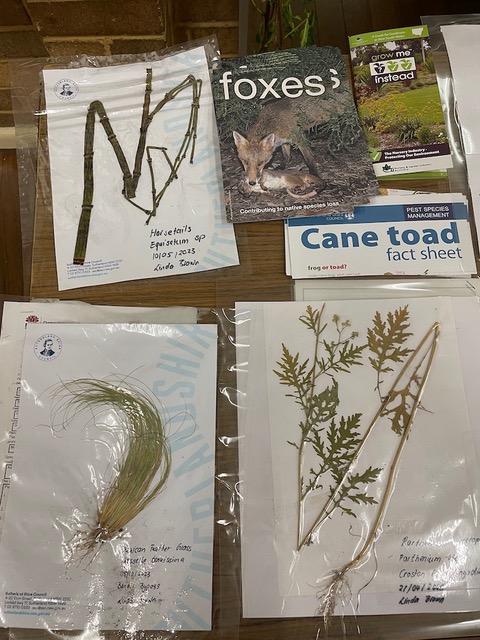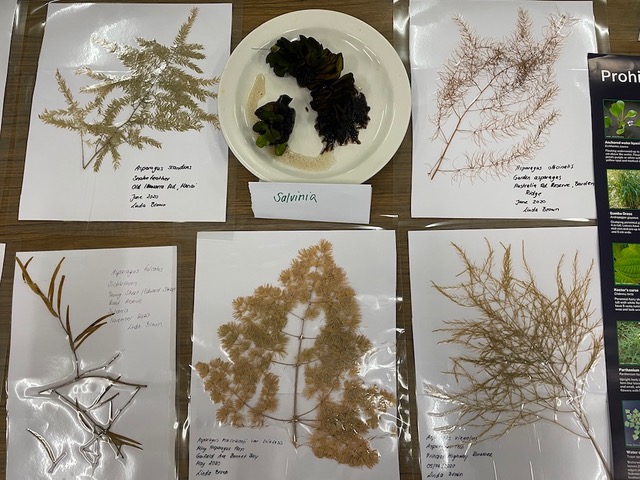Dan Clarke wrote this story on a talk that Invasive Species Officer Linda Brown gave at the Sutherland Group October meeting, on the Sutherland Shire Council Weed Species program.
Linda outlined the relatively recent changes to NSW legislation in how weeds are managed and categorised. The old concept of noxious weeds is now gone (I regret that I may not hear some people mistakenly refer to them as “obnoxious” any more); with the former Noxious Weeds Act 1993 replaced by the Biosecurity Act 2015 in NSW. Weeds can now be categorised as ‘priority weeds’ under this new Act.
There is a risk-based assessment and management of weeds in NSW, with a risk level and feasibility to control always assessed. Linda took us through the “generalised invasion curve” which shows the amount of economic return in terms of cost-effective measures. The curve goes through the stages of “prevention”, “eradication”, “containment” and “asset-based protection”. The return on economic investment declines drastically when we reach the containment and asset-protection stages for weed control and it usually means the weed has well and truly established; and has started to do serious ecological and economic damage.
Mexican Feather Grass is still classified as a prohibited matter and Linda found it growing on a road verge in Barden Ridge in 2020. Apparently, it was planted by someone in a garden there in the 1980s and it may have been purchased as a “native grass”.
Weeds can be categorised as “state priority weeds” and “regional priority weeds”. At the State level, these can be regulated through prohibited matters, control orders, mandatory measures and biosecurity zones. Regional weeds may represent a risk to a specific region (e.g., agricultural region) and management actions here are governed by regional weeds committees.
A crux of the legislation is that risk-based decision making together with prioritisation means that weed management response are reasonably practical, managed to the degree or risk posed and flexible and non-prescriptive.
Here I will refer you to this online pdf.
Linda has the power, as a council officer, to enter premises, gather information and evidence and seize plant or animal material for destruction later.
Linda gave us some front-line experiences, which involved a species call Mexican Feather Grass (Nassella tenuissima). A couple of species of Nassella are now well-known in NSW, such as Chilean Needle Grass (N. neesiana) and Serrated Tussock Grass (N. trichotoma). You can find Chilean Needle Grass in Sydney in some bushland reserves (often highly disturbed) and Serrated Tussock is easily found on farms as close as the Southern Highlands.

A survey of the Barden Ridge area was done and the grass was found in many road verges, as well as people’s front yards. This species was also growing on the Bangor Bypass. Once liaison with landowners was done, these grasses were removed and heavily targeted and a widespread and intensive education campaign was also undertaken. Plants along the Bangor Bypass were also targeted with the help of the RMS. Linda worked with the NSW Department of Primary Industries on this project, which demonstrates how serious it was. Linda mentioned that she and the DPI left the Shire to check out a nursery which was reportedly selling this species as a native species. These grasses can appear very similar to our native genera such as Poa and Austrostipa and mis-identifications are also exacerbating the introduction and spread, and causing general confusion.


We got a detailed education on aquatic weeds. We can imagine that these are very difficult to manage, often growing in shallow to deep fresh to brackish water with some invading drier land as well. Frogbit (Limnobium laevigatum) is a serious problem in dams and waterways and Linda has had to use her authority to control and eradicate it on some residences. Others include Water Lettuce (Pistia stratiotes) and Water Poppy (Hydrocleys nymphoides).
Salvinia (Salvinia molesta) is a very well-known aquatic fern that can double in size in two to three days. The dreaded Alligator Weed (Alternanthera philoxeroides) was also reviewed – a plant that forms densely and strongly-rooted mats, easily breaking off at the nodes if one tries to pull it up.
Other more dry-land species included Sea Spurge (Euphorbia paralias) and Glory Lily (Gloriosa superba) – weeds that have “gotten away from us” and caused severe ecological impacts. Annoyingly, people choose to grow them in gardens.
Linda reviewed some of the dreaded asparagus ferns. We would definitely be familiar with some of these in Sutherland Shire but we are now worried about more such as A. virgatus, A. macowanii, A. africanus and A. falcatus.
A few other well-knowns were shown such as Bitou Bush and Boneseed. These are two scientifically-demonstrated different subspecies of Chrysanthemoides monilifera. Boneseed invades areas much further inland whereas Bitou Bush tends to stick to sand dunes on the beach.
Linda has to deal with all of these in her daily tasks and has coordinated several programs in Sutherland Shire such as The Boneseed Program, Aquatic Weeds Program and the Mexican Feather Grass Program (as we heard earlier).
Of course, Linda does not only worry about plants but fauna are also part of her job. We all gasped when the Cane Toad (Rhinella marina) was found in Sutherland Shire at Taren Point in 2008, apparently hitching a ride within some pipes on a truck. A massive coordinated effort was made to capture and remove toads (including some nightly volunteer sessions) and the last toad was seen in 2014. But then….two toads were spotted in Caringbah in 2021. These were also captured! None have been seen since- whew!! It is due to Council and resident efforts that these have been contained.
A second species of concern is the Red-eared Slider Turtle (Trachemys scripta elegans). These have a terrible established track record for invading ecosystems around the world and the fear is they will do so here. They are often bought as pets and then let go once they get too large and start to smell.
There is not a lot we can do about the Red Fox, Koi Carp or Rusa Deer. These are here to stay but are subject to management projects.
Linda encouraged us to remain vigilant and to report any prohibited matters that we know of to Council or the Department of Primary Industries. We have a lot of established feral pests in Sutherland but we need to consider that more species could establish and invade the beautiful bushland areas we love.
This was a very informative talk that really made you want to “up-your-game” in terms of looking for biodiversity threats.
Dan Clarke
Editors note: We encourage you all to engage with your local council and find out what weed programs they have in place. Linda mentioned that different councils all have different funding and approaches, this is a good example of where local APS groups can engage and lobby council using our shared expert knowledge of Australian Plants on this very important issue.

